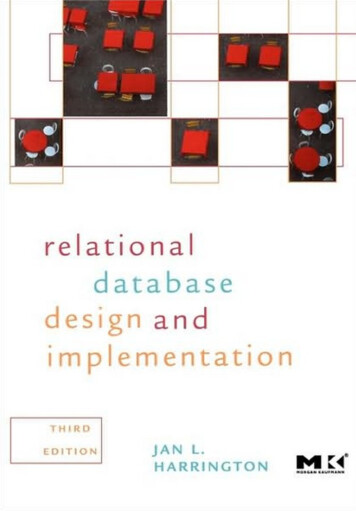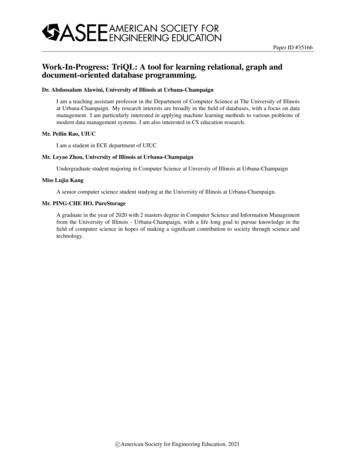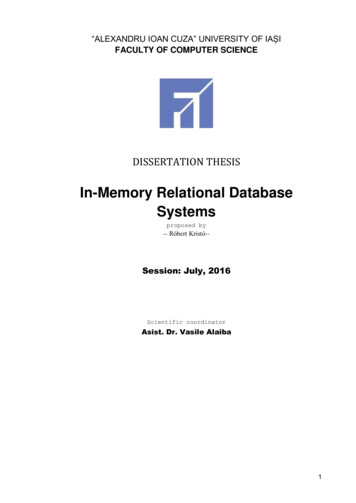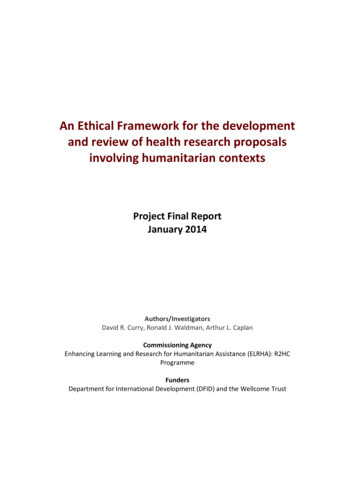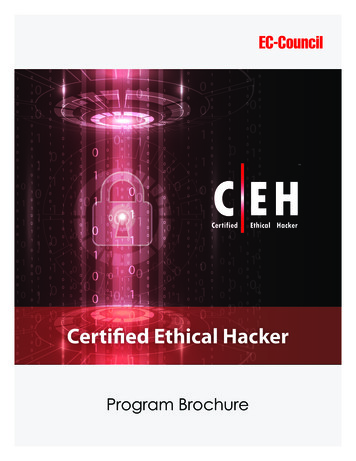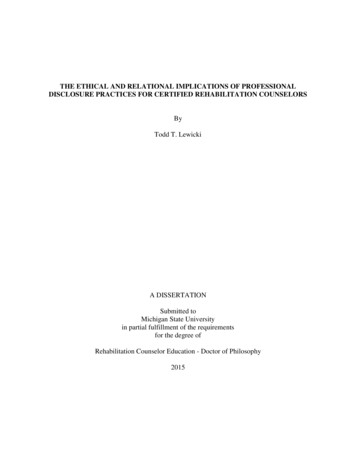
Transcription
THE ETHICAL AND RELATIONAL IMPLICATIONS OF PROFESSIONALDISCLOSURE PRACTICES FOR CERTIFIED REHABILITATION COUNSELORSByTodd T. LewickiA DISSERTATIONSubmitted toMichigan State Universityin partial fulfillment of the requirementsfor the degree ofRehabilitation Counselor Education - Doctor of Philosophy2015
ABSTRACTTHE ETHICAL AND RELATIONAL IMPLICATIONS OF PROFESSIONAL DISCLOSUREPRACTICES FOR CERTIFIED REHABILITATION COUNSELORSByTodd T. LewickiThe practice of professional disclosure involves the acknowledgement of the client’s right toautonomy and benefits client outcomes through fidelity, veracity, informed choice, thetherapeutic relationship, and genuineness. Professional disclosure is hypothesized to strengthenestablishment of an effective therapeutic relationship which leads to improved client outcomes.The Certified Rehabilitation Counselor (CRC) credential signifies that the CRC is well-preparedto practice in the field and operates consistently with the Commission on RehabilitationCounselor Certification (CRCC) 2010 Code of Professional Ethics. Little is known about CRCtherapeutic relationship outcomes relative to the use of professional disclosure practices,especially since the issuing of the 2010 CRCC Code of Professional Ethics for RehabilitationCounselors. The purpose of this study was to review CRC use of the practice of professionaldisclosure, and its relationship to the therapeutic relationship with the client. The study utilizedthe results of an online survey of 249 CRCs responding to questions on the Real RelationshipInventory-Therapist (RRI-T) and the Professional Disclosure Survey-Modified (PDS-M)instruments. Simultaneous multiple regression analyses were performed between thedemographic data and the two instruments. A simple linear regression was performed on theability of the PDS-M to predict outcomes on the RRI-T. The simultaneous multiple regressionsyielded relatively non-significant results, but the simple linear regression resulted in a significanteffect (F(1,197) 23.4, p .001), indicating that professional disclosure practices of the CRC
enhance the therapeutic relationship (genuineness) with the client. Implications for the field viaeducation, training, supervision, and future research are discussed.Keywords: CRC, ethics, informed consent, professional disclosure, rehabilitationcounselor, therapeutic relationship
Copyright byTODD T. LEWICKI2015
This dissertation is dedicated to two wonderful women whom I have been fortunate enough tohave in my life, through their seemingly endless capacity for unconditional love, thoughtfulness,caring guidance, and the belief that opportunities for success in achieving what an individual setsout to achieve are all but limitless and guaranteed when you have dedication, faith, andcompassionate support. In recognition, I am thankfully and immeasurably indebted to mymother Rosalie A. Lewicki, and my wife Antoinette M. Lewicki for being these wonderfulwomen and make this dedication on their behalf.v
ACKNOWLEDGEMENTSMy gratitude greets the start of each day and through this dissertation experience, isextended to my dissertation committee, my family, and my friends. The role each of you hasplayed has helped support, strengthen, and fortify my resolve to be more than I am; to elevate inme the never-ending and joyful desire to ask why and to tirelessly chase each answer and eachset of new questions. I am a ready pupil and I thank each of you for being there for me.I would like to express my heartfelt thanks and appreciation to my advisor, Dr. MichaelLeahy, who was an ever-present support, lending encouragement and thoughtfulness to myguidance. His propensity toward modeling the conviction necessary to be an innovative thinker,researcher, and teacher speaks to the strength of his own belief at being a sentinel in a field thatis in great need of those that advocate with and for persons with disabilities. I thank Dr. JohnKosciulek for his exceptional ability to enhance my sense of wonder and for eliciting thoughtfulways be to be precise, unexacting, and thoughtfully ethical. I thank Dr. Connie Sung for herpositivity and patience, spending the time I needed to get my analysis right. I thank Dr. EstherOnaga and Dr. Richard Coelho for their focus and emphasis on the depth of the questions andtheir relationship to pedagogy. I thank Dr. Vilia Tarvydas for her unequaled knowledge onethics (and wonderful demeanor), as it brought clarity and insight to my study. You are all giantfigures in my world-thank you.I also most of all thank my family: my wife Antoinette, sons Connor, Quinn, and Kael,my mother and father, and my sister and her family. All provided the support and patienceneeded for this endeavor. Lastly, I thank my classmates Erica Wondolowski and Susan Shermanfor their commiseration, encouragement and shared joy. A sincere thank you to all of you.vi
TABLE OF CONTENTSLIST OF TABLESxLIST OF FIGURESxiKEY TO ABBREVIATIONSxiiChapter OneIntroductionStatement of the ProblemPurpose of the StudyResearch QuestionsDefinition of Terms113568Chapter TwoLiterature ReviewCommon FactorsThe Working Alliance and the Therapeutic RelationshipThe Real RelationshipThe Empowerment Philosophy of the Rehabilitation Counselor PracticeClient Rights, Professional Disclosure, Informed Consent, and Informed ChoiceProfessional Disclosure’s Conceptual Link to the Therapeutic RelationshipProfessional Disclosure’s Place in Rehabilitation Counseling Ethical PrinciplesTheoretical er ThreeMethodsResearch QuestionsParticipantsSample SizeData Collection InstrumentsReal Relationship Inventory-Therapist FormProfessional Disclosure Survey-ModifiedProceduresVariables and Data AnalysisStudy Limitations5151525354545558636567Chapter FourFindingsInternal Consistency Reliability of the PDS-MResponse RateScreening and Preliminary Analysis of Initial Dataset7070717475vii
Review of Normality Assumptions in Complete DatasetRespondent Demographic CharacteristicsComparison to CRCC demographic characteristicsSummary of RRI-T Means and Standard DeviationsSummary of PDS-M Means and Standard DeviationsDummy CodingData Analysis: Quantitative and QualitativeSimultaneous multiple regression analysis: RRI-TQualitative data analysis: RRI-TRRI-T qualitative question 1RRI-T qualitative question 2RRI-T qualitative question 3Simultaneous multiple regression: PDS-MQualitative data analysis: PDS-MPDS-M qualitative question 1PDS-M qualitative question 2PDS-M qualitative question 3Simple linear regression: PDS-M as a predictor of RRI-TRRI-T subscale contribution to PDS-MPDS-M effect on genuineness subscaleEffect of presence of caseload on RRI-T and PDS-M 110112113Chapter FiveDiscussionSummary of StudyCRC Relationship OrientationPotential factors affecting CRC views on the therapeutic relationshipCRCs and Professional DisclosureRelevance of Professional Disclosure as a Relationship CatalystLimitationsRecommendationsImplications for Future 42APPENDICESAppendix APermission to Use Real Relationship InventoryAppendix BReal Relationship Inventory-Therapist Form (RRI-T)Appendix CProfessional Disclosure Survey-Modified (PDS-M)Appendix DDemographic Information FormAppendix EResearch Participant Informed Consent145146146147147148148150150152152viii
REFERENCES154ix
LIST OF TABLESTable 1: Comparison of Respondent and CRC Demographic Variable Characteristics81Table 2: Comparison of CRC Sample and CRC Population Demographic Characteristics:Job Setting83Table 3: Comparison of CRC Sample and CRC Population Demographic Characteristics:Job Title85Table 4: Internal vs. External Grouping, Mean, and Standard Deviations for RRI-TQuestions (n 199)89Table 5: Internal vs. External Grouping, Mean, and Standard Deviations for PDS-MQuestions (n 199)92Table 6: Means, Standard Deviations, and Intercorrelations for RRI-T, PDS-M, andPredictor Variables (n 196)97Table 7: Simultaneous Multiple Regression Analysis Summary for Demographic PredictorVariables on PDS-M (n 196)106Table 8: Simple Linear Regression Analysis Summary for PDS-M Predicting RRI-T(n 196)110Table 9: Means, Standard Deviations, and Intercorrelations for PDS-M, and RRI-TSubscale Predictor Variables (n 199)111Table 10: Simultaneous Multiple Regression Analysis Summary for RRI-T SubscalePredictor Variables on PDS-M (n 199)112Table 11: Simple Linear Regression Analysis Summary for PDS-M Predicting Genuineness(n 196)113Table 12: Means and Standard Deviations for CRCs With (n 145) and Without (n 54)Caseloadsx114
LIST OF FIGURESFigure 1: Framework for conceptualizing the role of the real relationship and professionaldisclosure in client empowerment48Figure 2: Re-envisioned framework for conceptualizing the role of the real relationship andprofessional disclosure in client empowerment129xi
KEY TO ABBREVIATIONSADAAmericans with Disabilities ActCDTEConsumer-Directed Theory of EmpowermentCORECouncil on Rehabilitation EducationCRCCertified Rehabilitation CounselorCRCCCommission on Certification of Rehabilitation CounselorsCRCECertified Rehabilitation Counselor ExaminationICC-VRTheory of Informed Consumer Choice in Vocational RehabilitationPDSProfessional Disclosure SurveyPDS-MProfessional Disclosure Survey-ModifiedRECITERehabilitation Counselor Initiated Transfer of EmpowermentRRI-TReal Relationship Inventory-TherapistTPBTheory of Planned BehaviorTRATheory of Reasoned Actionxii
Chapter OneIntroductionThe facilitation of informed client decision-making in health care has been a foundationfor understanding informed consent in rehabilitation counseling (Carlisle & Neulicht, 2010).Over a decade ago, the rehabilitation counseling field considered informed decision making to bea relatively new concept (Blackwell & Patterson, 2003). Insofar that the informed consentprocess is the rehabilitation counseling field’s acknowledgement of client right to autonomy, it isalso a further expression of recognition of the autonomy and dignity of the client through theembrace of the working alliance, empowerment, choice, and independence as key principles inits service philosophy (Patterson, Patrick & Parker, 2000). Embedded in informed consent is theconcept of professional disclosure, the process of communicating relevant information to clientsto engage them in understanding and agreeing to the elements involved in rehabilitationcounseling services (CRCC, 2010). With this philosophy in mind, Kosciulek (2005) identifiedthree underlying assumptions of client choice: 1) an informed client is the best authority on hisor her service needs, how to best meet these needs and whether they are being met; 2) servicedelivery environments can incorporate choice and control; and 3) client direction should beavailable to all. The belief in autonomy and choice should be based in the recognition of theclient’s right to choose his or her own goals and that rehabilitation counselors should utilize theirefforts and processes to help the client in reaching these goals (Tarvydas, Addy, & Fleming,2010).Exercising control over one’s life choices is directly related to individual autonomy. Theclient-oriented approach to decision-making diverges from the paternalistic medical model inthat it is empowerment-oriented and relies on the judgment and decisions of the client (Woolf et1
al., 2005). This focus on client autonomy is directly related to informed consent (Waller &Repko, 2008), which is the client’s right to consent to participate in and make informed andindependently-respected decisions with respect to rehabilitation services (Blackwell & Patterson,2003). Autonomy is one of the six ethical principles fundamental to the spirit of caring andrespect as described by the Code of Professional Ethics for Rehabilitation Counselors (CRCC,2010). Thus, the client has a right to receive information about the nature and outcome ofrehabilitation counseling services and to engage in informed choice and consent.Clients rely on the ethical nature of the rehabilitation counselor and the information theypossess regarding services and as a result, the rehabilitation counselor has an obligation toprovide them this information (Blackwell & Patterson, 2003). It is through this informationsharing that the client is given an opportunity to review, discuss and consent to engaging in thecounseling process. The treatment relationship is thought to be enhanced when the rehabilitationcounselor clearly defines throughout the counseling process and through professional disclosure,ongoing communication of the type of services being provided in addition to the client’s rightsand responsibilities within it (Blackwell & Patterson, 2003; Carlisle & Neulicht, 2010). Therehabilitation counselor should be knowledgeable in informed choice processes to assist theclient in becoming empowered and exerting greater control and influence over the choices anddirections of their own life (Kosciulek and Wheaton, 2003).Clients also expect that the skills and behavior of the counselor will affect their lives tothe positive. The counselor as an entity in the client counselor relationship is a therapeuticinstrument (Hayes et al., 1998). Bedics, Comtois, Atkins, & Linehan (2012) concluded that theimportance of the counselor in maintaining a positive stance toward the client, the use ofcounselor warmth and autonomy as interactive traits, positions the client for an improved2
outcome. This relates to a combination of the recognition of the respect and dignity for clients intreatment with a psychological treatment interwoven into the encounter, as Chwalisz (2001)noted. The rehabilitation counseling relationship has sought to engage the client in empoweredand informed life choices, inclusion and independence (Kosciulek and Wheaton, 2003).Research on attitudes of clinical workers regarding expected client outcomes has shown apositive effect on client improvement in medical studies (Adcock, Goldberg, Patterson, &Brown, 2000).Statement of the ProblemIt is the rehabilitation counselor’s responsibility to engage the client in as much decisionmaking autonomy as possible (Hagen-Foley, Rosenthal & Thomas, 2005). Carlisle & Neulicht(2010 ) note that the Commission on Rehabilitation Counselor Certification (CRCC), in its 1987Code of Professional Ethics, first mentioned professional disclosure, but did not cover it indepth. As the CRCC issued its 2001 Code of Professional Ethics, informing the client hadevolved to include the recommendation that the client receive information on counselorcredentials as well as the purpose, limitations, benefits and risks of services, but had noimplementation requirement; rather a recommendation that this information be provided in awritten format when testing individuals (Blackwell, Autry, & Gugliemo, 2001). The process bywhich the rehabilitation counselor followed this recommendation greatly varied in practice andin outcome.Shaw, Chan, Lam and McDougall (2004) acknowledged the importance of adequateprofessional disclosure and noted an increase in the number of ethics complaints in this area.Due to a lack of knowledge on prevalence of the use of informed consent, the CRCC EthicsCommittee recommended a study look at current processes and potential best practices to better3
understand how professional disclosure was being implemented within the field of rehabilitationcounseling. It was found that there was great variability in the content and use of professionaldisclosure forms, leading to the potential for added liability and accountability problems. Thefindings revealed that rehabilitation counselors did not regularly inform their clients on the limitsof confidentiality and situations involving a legal duty to report situations of abuse or neglect.Informed consent, insofar as it was connected to client autonomy, choice, empowerment, and theworking alliance, was not used with enough of a standard, predictable approach to quantify thatthe client right to disclosure at service initiation and throughout was used effectively or in anyconsistent fashion.In 2010, CRCC issued its most current Code of Professional Ethics (CRCC, 2010) todate. One of the most significant changes to the 2010 code was that written professionaldisclosure became a requirement (Carlisle & Neulicht, 2005). Furthermore, the 2010 codeindicates “rehabilitation counselors need to recognize diversity and embrace a cultural approachin support of the worth, dignity, potential, and uniqueness of individuals with disabilities withintheir social and cultural context” (CRCC, 2010, p.1). The 2010 code also underscores theprinciple of autonomy through the respect of the rights of clients “within their social and culturalframework” (p. 2). Thus, informed consent processes and cultural competence are both viewedas important mechanisms in the rehabilitation counselor’s effort to engage and empower theclient.The Shaw et al. (2004) study indicated that the field of rehabilitation counseling lackedknowledge in the prevalence of professional disclosure practices to the client. Tarvydas andBarros-Bailey (2010) used an open-ended survey with 240 CRCs and Canadian CRCs regardingcurrent and anticipated ethical dilemmas in the field. The analysis of the respondents’ reports4
showed that three of the top four ethical concerns included confidentiality and exceptions toconfidentiality, autonomy and client choice, and the client relationship. Each of these areas ofconcern is related to professional disclosure. The issue of the adequacy of informed consent andlimits of confidentiality stood out in light of third-party referral, payer, and referral sources.Kosciulek (2007) also noted that valid models are needed to guide development, implementation,and evaluation of disability and rehabilitation services and that little information exists regardingconstructs that could be useful in conceptualizing ways to examine and enhance informedconsumer choice.The failure in appropriate disclosure of counselor credentials as well as the purpose,limitations, benefits and risks of services has the potential for resulting in far-reaching anddeleterious outcomes for all persons involved, including loss of client trust in the counselor,service disruption and malpractice lawsuits (Baerger, 2001; Woody, 2000). Kosciulek andWheaton (2003) noted that an effective working alliance was a primary factor in all successfulcounseling practices. Also referred to as the therapeutic alliance, the working alliance is definedas the bond between the client and the counselor, agreement on goals, consensus on therapeutictasks and has been found to be significantly related to treatment outcome (Carter, 2006). Thus,the therapeutic relationship is a part of the alliance and, being central to successful treatmentoutcomes, is built upon a trusting bond that should be strengthened by a well-implementedinformed choice process.Purpose of the StudyThe field of rehabilitation counseling has had a responsibility to address clientempowerment for informed choice by embedding it in the rehabilitation process itself (Breeding,2008). Rehabilitation counseling practitioners, educators and researchers have engaged in5
numerous studies including role and function studies, training needs, the future of the profession,and student perception of the amount of time devoted rehabilitation counseling activities in anattempt to better define rehabilitation counseling as a true profession (Zanskas & Strohmer,2010; Muthard & Salamone, 1969; Rubin, 1984; Chan et al., 2003; Leahy 2009; Lustig &Strauser 2008, 2009). One key trait in establishing the effectiveness of the rehabilitationcounselor is measured by their ability to make relational connections with clients (Koch,McReynolds, & Rumrill, 2004). However, little is known about rehabilitation counselorprofessional disclosure practices and the effect these have in the therapeutic relationship, as therehave been few studies on this area, especially since the issuing of the 2010 CRCC Code ofProfessional Ethics for Rehabilitation Counselors.Kosciulek and Wheaton (2003) hypothesized that an effective therapeutic relationshipleads to productive informed choice in the rehabilitation counseling process. It was this writer’scontention that certified rehabilitation counselor use of the informed choice process ofprofessional disclosure would serve to contribute to and strengthen the cultivation of a genuinerelationship with the client and strengthen the transference of empowerment to the client.Revisiting and subsequently advancing the current knowledge and practice of certifiedrehabilitation counselors (CRC) relative to the interaction of these processes was warranted,given the lack of studies in this area, especially in relation to the influence of the informedconsent requirement in the 2010 CRCC Code of Professional Ethics for RehabilitationCounselors (referred to hereafter as “the 2010 Code”). Thus, the purpose of this study was toreview the CRC use of the practice of professional disclosure, and its potential relationship toclient empowerment through a strengthened therapeutic relationship.Research Questions6
This study attempted to address a gap in the rehabilitation counseling literature relating tothe influence of the rehabilitation counselor empowerment orientation on rehabilitation counselorpractices relating to informed consent requirements (professional disclosure), as defined by the2010 Code. Ostensibly, the study sought to review the relationship between the rehabilitationcounselor’s professional disclosure practices and whether they correlated with an enhancedtherapeutic relationship.1. How do the following rehabilitation counselor demographic characteristics predict/affectthe rehabilitation counselor’s use of informed consent?a. The age of rehabilitation counselor.b. The gender of the rehabilitation counselor.c. The race of the rehabilitation counselor.d. The education level of the rehabilitation counselor.e. The experience level of rehabilitation counselor.f. The job setting of rehabilitation counselor.g. The job title of rehabilitation counselor.2. How do the following rehabilitation counselor demographic characteristics predict/affectthe rehabilitation counselor’s use of the real relationship?a. The age of rehabilitation counselor.b. The gender of the rehabilitation counselor.c. The race of the rehabilitation counselor.d. The education level of the rehabilitation counselor.e. The experience level of rehabilitation counselor.f. The job setting of rehabilitation counselor.7
g. The job title of rehabilitation counselor.3. How well do rehabilitation counselors that exhibit more positive scores on theprofessional disclosure survey-modified predict positive opinions on use of the realrelationship-therapist inventory with the client?Definition of TermsCertified Rehabilitation Counselor (CRC). The credentialing process issued by theCommission on Rehabilitation Counselor Certification, recognized as the oldest and mostestablished certification mechanism in the counseling and rehabilitation disciplines in the UnitedStates. The CRC standards and examination content represents the education level, experience,and knowledge competencies required of rehabilitation professionals to provide rehabilitationcounseling services to persons with disabilities (Leahy, Chan, Sung, & Kim, 2013).Commission on Rehabilitation Counselor Certification (CRCC). The credentialingbody established in 1973 to ensure accountability and promote the quality of rehabilitationcounseling services to persons with disabilities (Saunders, Barros-Bailey, Rudman, Dew, Garcia,2007).Common Factors. Common elements in counseling, such as the healing context, theworking alliance, and belief in the rationale for treatment and in the treatment itself, are theimportant therapeutic aspects that enhance or create the opportunity for change (Ahn &Wampold, 2001).Empowerment. The attainment of identity goals and the psychological aspect of theself-perception that an individual has in them a capacity to influence his or her environment(Daniels, 2002).8
Informed Choice. Information that has been provided to, understood, and used by theclient for the purpose of making a choice established through on engaging the client in theinformed consent process (Entwistle, Sheldon, Sowden, & Watt, 1998).Informed Consent. A process of communication between the rehabilitation counselorand client for the purpose of the authorization or decision by the client to pursue a particulardirection in services based upon an appreciation and understanding of the facts and implicationsof an action (CRCC, 2010).Professional Disclosure. The act of sharing the information needed to understand thenature and characteristics of the counseling process, with a goal of supporting and advancingautonomous decision-making (Shaw & Tarvydas, 2001).Real Relationship. The personal relationship that is thought to exist between individualsas reflected in the degree to which each is genuine with the other and perceives the other in waysthat befit the other (Gelso et al., 2005).Rehabilitation Counselor. Counselors that are ethically obligated to act in ways thatcontribute to the empowerment of persons with disabilities with resources that lead to the bestpossible outcomes in the least restrictive environments; facilitate the rehabilitation processthrough use of a unique set of holistic skills in assisting persons to reach their highest level ofpsychosocial functioning; and embrace a philosophy that results in clients achieving personallyfulfilling, socially meaningful, emotionally healthy independent lives (Stebnicki, 2009).Therapeutic Relationship. Relationship components in the therapy relationship thatinclude counselor and client mutual feelings and attitudes, the working alliance, empathy, goalconsensus, collaboration, countertransference management, positive regard, and congruence; all9
are thought to contribute to treatment outcome (Kivlighan, Gelso, Hummel, Ain, & Markin,2014).Working Alliance. The level of alliance between the counselor and client that includesthree parts; 1) the affective bonds between client and counselor, 2) the mutually agreed upongoals, 3) and the level of task teamwork and personal rapport during the service process (Bordin,1979).10
Chapter TwoLiterature ReviewThe purpose of this study was to review the CRC orientation toward the therapeuticrelationship with the client and their perception of the benefit the professional disclosure use hason this relationship. Accordingly, a thorough literature review was necessary to explore theconcepts and their relative importance when considering aspects of empowerment, informedchoice, shared decision-making, the 2010 Code, and ethical behavior. Additionally, the reviewincluded the role of the rehabilitation counselor in using informed consent practices and theinfluence that counselor perspectives (i.e. relational attitude) had on the client-counselorrelationship on service delivery and potential outcomes. Definitions of terms have been includedprior to this literature review, and where appropriate and in subsequent sections as well. Thisreview occurred in support of the need for further research in the area of rehabilitation counselorinformed consent practices and the potential these practices have on establishing the bestpossible environment for positive client outcomes.Johann Wolfgang von Goethe (1749-1832), a German writer, captured what one couldview as a prerequisite to the rehabilitation counselor’s perspective on dignity and respect towardthe client: “If you treat an individual as he is, he will remain how he is. But if you treat him as ifhe were what he ought to be and could be, he will become what he ought to be and could be”(goodreads, n.d.). The self-fulfilling prophecy, arguably what Goethe was inadvertentlyreferring to, is an important concept that is relevant in the relationship with the client. The selffulfilling prophecy refers to the symbolic idea that once something is defined as real, it is alsoreal in its consequence (Wiley, 2003). Thus, this research attempted to speak to the counselorclient interaction and the contributions that counselor perspectives can have on managing the11
therapeutic relationship and more specifically, the impact that this orientation and theempowering effect informed consent theoretically can have on strengthening outcomes.Common FactorsCoined by Saul Rosenzweig in 1936, common factors theory has been has been studiedand has gained legitimacy in psychotherapeutic practice (Wampold et al., 1997). Numeroustherapeutic techniques and practices exist and Rosenzweig’s common factor theory cites thatcommon factors are largely responsible for the efficacy of the psychotherapy. Common factorsare interactive relational elements not thought to belong to any specific therapy but rather areshared properties possessed by all treatment techniques. Lambert and Ogles (2004) separatedcommon factors into three categories: support factors, learning factors and action factors.Support factors include catharsis, identification with therapist, mitigation of isolation, positiverelationship, reassurance, release of tension, structure, therapeutic alliance, therapist/client activeparticipation, therapist expertness, warmth, respect, empathy, acceptance, genuineness and trust.Learning factors include advice, affective experiencing, assimilating problematic experiences,cognitive learning, corrective emotional experience, feedback, insight, rationale, exploration ofinternal frame of reference, and changing expectations of personal effectiveness. Action factorsinclude behavioral regulation, cognitive mastery, encouragement of facing fears, taking risks,mastery efforts, modeling, practice, reality testing, success experience and wo
Client Rights, Professional Disclosure, Informed Consent, and Informed Choice 30 Professional Disclosure's Conceptual Link to the Therapeutic Relationship 37 Professional Disclosure's Place in Rehabilitation Counseling Ethical Principles 41 Theoretical Framework 42 Model 45 Summary 49 Chapter Three 51 Methods 51 Research Questions 52




